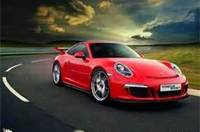J.D. Power Reports: Striking a Balance Between Desktop and Tablet Experiences Drives Auto Manufacturers to Improve Website Functionality
 2013 Porsche 911 GT3 |
Acura and Porsche Tie for Highest Rank in Manufacturer Website Evaluation Study Satisfaction
WESTLAKE VILLAGE, CA--July, 24 2013: As tablet adoption continues to increase, automotive manufacturers strive to provide a satisfying website experience for both desktop and tablet users by improving functionality for both devices, according to the J.D. Power 2013 Manufacturer Website Evaluation StudySM (MWES)—Wave 2 released today.
The semiannual study, now in its 14th year, measures the usefulness of automotive manufacturer websites during the new-vehicle shopping process by examining four key measures (in order of importance): information/content, navigation, appearance and speed.
According to the study, tablet ownership increases 145 percent among new-vehicle shoppers, a substantial increase to 49 percent in 2013 Wave 2 from 20 percent in 2012 Wave 1. Overall satisfaction among tablet users remains stable at 815 (on a 1,000-point scale) in 2013 Wave 2, compared with 818 in Wave 1. Overall satisfaction among desktop users is 823. Notably, satisfaction among tablet users is lower than among desktop users in two key measures: navigation (804 vs. 817, respectively) and speed (812 vs. 831, respectively). These substantial differences are the result of most manufacturer websites being designed for a desktop.
While it is possible to navigate many desktop-optimized websites on a tablet, navigation and website functionality may not be fully optimized for tablet navigational behaviors. Therefore, manufacturers continue to refine functionality to meet the needs of both desktop and tablet users. Considering the varying screen sizes among desktops and tablets, a critical challenge for manufacturers is finding the right balance to accommodate both desktop users and the growing population of tablet users.
Manufacturers have wrestled with how to accommodate tablet users on their sites. Some websites direct tablet users to their mobile website instead of the desktop site. However, this practice may be problematic due to the reduced amount of content generally available on a mobile site. Most manufacturers currently rely on one of three strategies to accommodate tablet users: 1) send users to their desktop site; 2) send users to a separate site designed for tablets; or 3) offer a responsive design website that accommodates desktop, tablet and mobile users. Responsive design, which automatically modifies websites to accommodate any device and screen size, has gained popularity across many non-automotive websites with some manufacturers having made the transition to this format.
"Launching a responsive design website requires a big commitment, requiring a major overhaul of the site, including extensive development time and cost by manufacturers. The resulting benefit, however, is that it provides a consistent user experience regardless of the screen size or device," said Arianne Walker, senior director of media and marketing solutions at J.D. Power. "There is definitely positive movement with the adoption of responsive design websites in the automotive industry. For example, during the study fielding period, Lexus's responsive design website was already active and Mercedes-Benz introduced responsive design on one of its model pages. This is not just a trend in automotive, it is being deployed by businesses in other industries, including global quick-service coffee chains, consumer and enterprise software manufacturers and newspapers. J.D. Power believes this approach may be one good solution to address the challenge of accommodating device proliferation."
Study Rankings Acura and Porsche (in a tie at 853 each) rank highest in overall satisfaction. Dodge (851) ranks third, followed by Infiniti and Jaguar (848 each). Overall satisfaction with automotive brand websites averages 823.
The 2013 Manufacturer Website Evaluation Study—Wave 2 is based on responses from 10,196 new-vehicle shoppers who indicate they will be in the market for a new vehicle within the next 24 months. The study was fielded May 8, 2013, through May 22, 2013.
Overall Customer Satisfaction Index Scores (Based on a 1,000-point scale)
Acura
853
Porsche
853
Dodge
851
Infiniti
848
Jaguar
848
Jeep
839
Fiat
832
smart
832
Land Rover
831
Hyundai
828
Kia
828
Ram
825
Mitsubishi
824
Chrysler
823
Honda
823
Industry Average
823
Mercedes-Benz
821
Ford
819
Mazda
819
MINI
819
Nissan
819
Cadillac
818
Lexus
818
Scion
818
Volkswagen
818
Chevrolet
815
Lincoln
813
Buick
811
BMW
809
Toyota
809
GMC
803
Subaru
803
Volvo
799
Audi
794


